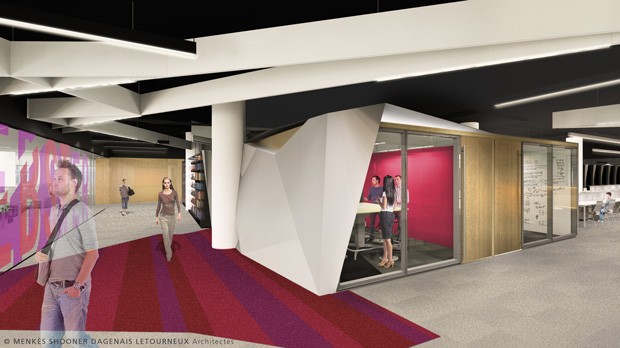A 21st-century vision for the Webster Library
 Interim university librarian Guylaine Beaudry: “Libraries are no longer places that exclusively provide spaces for silent study, but rather places that also foster collaborative learning.” | Courtesy of Menkès Shooner Dagenais Le Tourneux architectes
Interim university librarian Guylaine Beaudry: “Libraries are no longer places that exclusively provide spaces for silent study, but rather places that also foster collaborative learning.” | Courtesy of Menkès Shooner Dagenais Le Tourneux architectes
With 11 different categories of study areas, technology-equipped collaborative spaces, 3D printers and zero-noise rooms, the vision for the upgraded R. Howard Webster Library embraces innovation.
When Guylaine Beaudry, interim university librarian, took to the stage during two well-attended information sessions on March 4 and 7, she painted a picture of a facility in much need of a transformation — and presented a vision for a 21st-century century library.
Beaudry reminded the audience of the basic role of university libraries — that they serve as the foundation for academic life by providing spaces where students can take charge of their own education by immersing themselves in intensive study or collective learning.
“Libraries are no longer places that exclusively provide spaces for silent study, but rather places that also foster collaborative learning,” she said.
She presented architectural renderings of bright, airy spaces that would see the number of student seats in the library rise from 1,550 to 3,400 and the facility’s overall space increase by 27 per cent.
The plans include spaces where students will be able to fully immerse themselves in intensive study or collaborative learning; these range from areas for silent study to group study rooms equipped with screens, cameras and speakers with connections for laptops or tablets, as well as whiteboard surfaces and podiums for practising presentations.
Additionally, the plans provide for 2,000 seats in one of the library’s seven large study halls, zero-noise rooms and a technology sandbox that will showcase new technologies and encourage peer-to-peer learning, experimentation and collaboration.
Beaudry also pointed to the global shift in academic libraries from a print to digital culture in their increased focus on providing electronic access to scholarly publications.
A necessary upgrade
Beaudry’s plans for the Webster Library promise to deliver.
The facility, now 22 years old, was opened in 1992. Over the course of its existence, student enrolment at Concordia has tripled.
Traffic from 46,000 students translates to nearly two million library visits per year; at peak times, some students are seated on the library floor, while others circle to find study spaces.
Then there are those who simply cannot find group study rooms or fully concentrate due to higher-than-average noise levels resulting from crowding.
The final plans and budget for the Webster Library transformation will be presented to the Board of Governors for approval this fall.
View the presentation on the transformation project, and share your comments by sending a message to Nadia Masi, assistant to the university librarian.